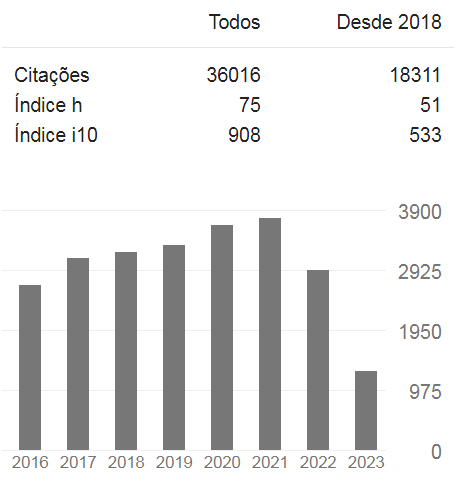Depression in diabetic people: dnveiling the hidden enemy
DOI:
https://doi.org/10.35699/2316-9389.2013.50198Keywords:
Diabetes Mellitus type 2, Depression, CopingAbstract
Depression occurs in Diabetes Mellitus (DM) patients, being often cared for and mistaken by health workers and by patients themselves, as sensations of annoyance, sadness and melancholia. Studies show that depression can be a major difficulty in the coping process of the disease. The aims of this study were to understand how the DM-type 2 patient identifies and experiences depression, describing signs and symptoms present in their daily routine and identify the coping strategies used. The study sample was composed of diabetic type 2 insulin-dependent patients, over fifty years old that attended to the program Preventive Medicine Service - Unimed G.V. (Medical work Co-Operative of Governador Valadares). The methodological and theoretical reference used was the oral thematic history proposed by Meihy. Data from thirteen interviews were analized and the concepts emerged enabled the identification of three central themes: life conditions of a diabetic person that influence depression, identification of depression and the meaning of depression for a diabetic patient. Signals and symptoms of depression indicated by diabetics were: lack of appetite, irritability, fear of complications and others. The participants recognized depression through changes perceived in the behavior, melancholia, anxiety, crying for no apparent reason, loss of interest, difficulty to concentrate, insomnia and thoughts about death. Depression as described was related to feelings of loneliness, financial and marital problems. The nurse must be trained to perceive and interfere early in depression, develop an effective plan of care and of adherence to treatment, using educational programs and utilizing the various therapeutic alternatives.Downloads
References
Sociedade Brasileira de Diabetes. Consenso Brasileiro sobre diabetes.
Diagnostico e classificação do diabetes melittus e tratamento do diabetes
tipo 2. [Citado em 2002 jul. 20]. Disponível em: www.diabetes.org.br.
Brasil. Ministério da Saúde. Secretaria de Políticas de Saúde. Plano de
reorganização da atenção à hipertensão arterial e ao diabetes mellitus:
hipertensão arterial e diabetes mellitus. Brasília: Ministério da Saúde; 2002.
Malerbi DA. Evolução crônica do diabetes mal controlado. In: Atualização
em Diabetes do tipo 2 para o clínico não-especialista. São Paulo: Sociedade
Brasileira de Diabetes; 1998, p.10.
Anderson RJ, Freedland KE, Clouse RE, Lustamam PJ. The prevalence of
comorbid depression in adults with diabetes. Diab Care 2001; 24:10069-78.
Zanetti ML. Papel educativo do enfermeiro e o locus de controlo da pessoa
diabética, 1990 [dissertação]. Riberão Preto: Escola de Enfermagem de
Ribeirão Preto, Universidade de São Paulo, 1990.
Maudsley H. The patology of mind. 3th ed. New York: Appleton; 1899.
Lustaman PJ, Griffith LS, Clouse RE. Recorgnizing and managing depression
in patients with diabetes. In: Rubin RR, Anderson BJ. Pratical psychologry for
diabetes clinicians. Am Diab Assoc. 1996; 143-52.
Zauszniewski JA, Chung CW, Krafcik K, Souza VD. Psychometric testing of
the depressive congition scale in women with type 2 diabetes. J Nurs Meas.
; 9(1): 61-72.
Organization Panamericana de la Salud-OPAS. Orgnization Mumdial de la
Salud- OMS. Programa de Salud Mental. Division de Promocion de Salud.
Modelo para la capacitacion de la enfermera general en ai identificacion y
manejo de los transtornos afetivos.Generalista I. Genova: OMS; 1999.
Willians A, Strasser PB. Depression in the workplace: impact on employees.
AAOHN J. 1999 Nov;47(11):526-37.
Maas ML, Buckwalter KC, Hardy MD, Reimer TT, Titler MG, Spech JP. Nursing
care of older adults diagnoses, outcomes, e interventions. St. Louis: Mosby; 2001.
Leedom L, Meehan WP, Procci W, Zeidler A. Symptoms of depression in
patientes with type 2 diabetes mellitus. Psychomatics. 1991;32:280-6.
Robins LN, Regier DA. Psychiatric disorders in America the epidemiologic
catchment area study. New York: Free Press; 1991.
Culbertston JA. Depression and gender an international review. Am Psychol.
; 52:25.
Gavard JA, Lustman PJ, Clouse RE. Prevalence of depression in adults with
diabetes an epidemiological evalution. Diabetes Care. 1993; 16:1167-78.
Carney C. Diabetes Melittus and major depressive desorder: an overview of
prevalence, complications, and treatment. Depress Anxiety. 1998; 7(4):149-57.
Van TM, Mccasckill CC, Lane JD. Depressed mood is a factor in glycemic
control intype 1 diabetes. Psychosom Med. 2001; 63:551-5.
Roy A, Roy M. Depressive stomptoms in African American type 1 diabetics.
Depress Anxiety. 2001; 13:28-31.
Minayo MC. O desafio do conhecimento - pesquisa qualitativa em saúde. 3ª
ed. São Paulo: Hucitec-Abrasco; 1994.
Freitas SM. História oral. Possibilidades e procedimentos. São Paulo:
Humanitas da USP; 2003.145 p.
Meihy JCSB. Manual de história oral. São Paulo: Loyola; 1996.
Camargo A. História oral e política. In: Moraes MD. História Oral. Rio de
Janeiro: CPDOC/Fundação Getúlio Vargas/Diadorim; 1994.
Moreira RO, Papelbaum M, Appolinario JC. Diabetes Mellitus e depressão:
uma revisão sistemática. Arq Bras Endocrinol Metab. 2003; 47(1):19-29.
Lustman PJ, Griffith LS. Depression in women with diabetes. Diabetes
Spectrum. 1997; 10:216-23.
Carney RM, Freedland KE, Lustman PJ, Griffith LS. Depression and coronary
disease in diabetic patients: a 10 - year followup. Psychosom Med. 1994; 56:149.
Carney C. Diabetes Melittus and major depressive desorder: an overview of
prevalence, complications, and treatment. Depress Anxiety. 1998; 7:149-57.
Bailey BJ. Mediators of depression in adults in diabetes. Clin Nurs Rev. 1996;
(1):25-42.
Lustman PJ, Griffith LS, Clouse REE. Depression in adults with diabetes:
results of a 5-year follow-up study. Diabetes Care. 1998; 11:605-12.
Van TM, Mccasckill CC, Lane JD, Edwards CL, Bethel A, Feinglos MN, et al.
Depressed mood is a factor in glycemic control intype 1 diabetes. Psychosom
Med. 2001; 63:551-5.
Kelsey JE. Depressão e família. [Citado em 2004 jun. 24]. Disponível em
.
Miyaoka Y, Miyaoka H, Motomiya T, Kitamura S, Asai M. Impact of
sociodemographic and diabetes-related characteristics on depressive state among
non-insulin-dependent diabetic patients. Pych Clin Neurosci. 1997; 51:203-6.
Ross EK. Sobre a morte e o morrer. 8ª ed. São Paulo: Martins Fontes; 1998.
Bailey C J, Turner RC. Metformim. N Engl J Med. 1996; 334:574-9.
Myaoka Y. Impact of sociodemographic and diabetes-related characteristics
on depressive state among non-insulin-dependent diabetic patients. Pych
Clin Neurosci. 1997; 51:203-6.
Connel CM, Davis WK, Gallant MP, Sharpe PA. Impact of social support,
social cognitive variables, and perceived threat on depression among adults
with diabetes. Health Psychol. 1994; 13:263-73.
Osinaga VLM. Saúde e doença mental: conceitos e assistência segundo
portadores, familiares e profissionais [dissertação]. Ribeirão Preto: Escola de
Enfermagem da Universidade de São Paulo; 1999.
Pace AEEC. O conhecimento dos familiares acerca da problemática do portador
de Diabetes mellitus. Rev Latinoam Enferm. 2003 maio/jun; 11(3):312-9.
Malerbi DA. Evolução crônica do diabetes mal controlado. In: Sociedade
Brasileira de Diabetes. Atualização em Diabetes do tipo 2 para o clínico nãoespecialista. São Paulo: Sociedade Brasileira de Diabetes, 1998; 2:10.
Rogers M. Enfermagem no ano 2020: cinco cenários futuros. Toronto:
Canadian Nurses Association; 1997.
Published
How to Cite
Issue
Section
License
Copyright (c) 2013 Reme: Revista Mineira de Enfermagem

This work is licensed under a Creative Commons Attribution 4.0 International License.






































